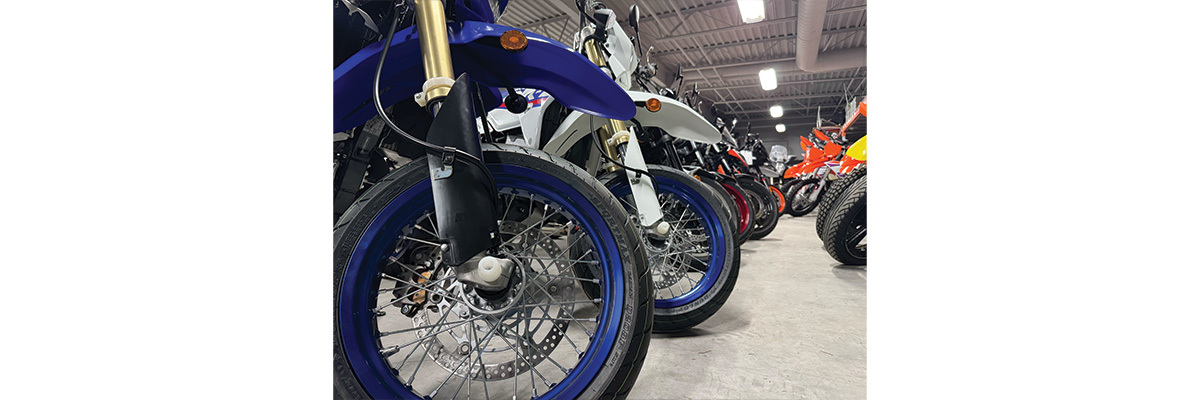
Here are a few simple storage preparation tips to help ensure that you can be out riding your bike in the spring, instead of waiting to get in for service.
1. Location
When deciding on a place to store your motorcycle, look for a place that is dry and out of harm's way. When possible, choose a location away from windows. The ultraviolet light can fade paint and plastic parts. Direct sunlight can raise the ambient temperature of the storage area which will promote condensation when the sun goes down, so cover plain glass with some sort of opaque material. Also, cover your bike with a specially designed bike cover, not a sheet or a tarp. Why? Because a sheet absorbs moisture and can hold it against metal surfaces and then rust starts. Also, the damp fabric will breed mildew and this may attack the seat material. A tarp prevents moisture from getting in but also prevents it from getting out. Moisture trapped will condense on the bike and then the rust monster is back! A specially designed motorcycle cover is made of a mildew resistant material. The material is slightly porous, so it can breathe.

2. Change the Oil
Even if the oil is not due for a change, byproducts of combustion produce acids in the oil which will harm the inner metal surfaces. Warm the engine to its normal operating temperature, as warm oil drains much faster and more completely. This is a good time to change your oil filter as well. Please remember to dispose of the drained oil and old filter in a responsible manner.
3. Add Fuel Stabilizer and Drain Carburetors
Fill the tank with fresh fuel, but do not overfill. The correct level is when the fuel just touches the bottom of the filler neck. This gives enough room for the fuel to expand without overflowing the tank when the temperature rises.
Shut off the fuel petcock and drain the carburetors and the fuel lines. Add winterizing fuel conditioner to prevent the fuel from going stale, and help prevent moisture accumulation. Stale fuel occurs when aromatics (the lighter additives) evaporate leaving a thicker, sour smelling liquid. If left long enough, it will turn into a gum, plugging the jets and passages inside your carbs. PLEASE NOTE: Some BMW models can't use Fuel Conditioner containing alcohol.
4. Lubricate the Cylinder(s)
Because gasoline is an excellent solvent, and the oil scraper ring has done its job, they have removed most of the oil from the cylinder walls the last time the engine was run. If the cylinder wall is left unprotected for a long period of time, it will rust and cause premature piston and ring wear.
Remove the spark plug(s) and pour a tablespoon of clean engine oil into each cylinder. Be sure to switch off the fuel before you crank the engine, or you might refill the drained carbs. Also, ground the ignition leads to prevent sparks from igniting any fuel residue. Turn the engine over several revolutions to spread the oil around and then reinstall the plugs. (You might find that this is a good time to install new spark plugs.) Refitting the plugs before cranking the engine could result in a hydraulic lock if too much oil was used in the cylinder.
5. Battery Storage
The battery must be removed from the motorcycle when it is in storage. Motorcycles often have a small current drain even when the ignition is switched off. A discharged battery will sulphate and no longer be able to sustain a charge.
A conventional, or non-maintenance-free battery should be checked for electrolyte level. Add distilled water to any of the cells that are low, and charge the battery.

Battery charging should be performed at least every two weeks using a charger that has an output of 10% of the battery ampere hour rating. For example, if the battery has an AH rating of 14, then the charge of the battery should not exceed 1.4 amps. A higher charge will cause the battery to overheat. Charge the battery away from open flame or sparks, as the gas given off by a battery can be explosive.
6. Service all Fluids
If the brake or clutch fluids haven't been changed in the last two years of 18000km, do it now. The fluids used in these systems are hygroscopic which means that they absorb moisture. The contaminated fluid will cause corrosion inside the systems which may give problems when your motorcycle is used next spring. Be sure to use the correct fluids and note the warnings and instructions in your service manual.
If your motorcycle is liquid cooled, the coolant requires changing every two years or 24,000km. Make sure that the engine is cool enough to rest your hand on it before draining the system. Also, please remember to dispose of the old coolant responsibly.
If you do not have the experience to service these systems, contact us, and we will be happy to offer you assistance.
7. Final Preparation
Give your bike a good cleaning and dry it thoroughly. If your bike is chain driven, apply a quality chain lube. Spray a light oil, such as WD-40, into the muffler ends and drain holes and give the painted surfaces and uncoated aluminum parts a good coat of wax.
Check the air pressures of your tires. If the bike has a center stand, use it and put a block under the engine to raise the front wheel off the ground. If your bike doesn't have a center stand, or work stand, then the tire pressures should be set at the maximum load pressure to help prevent flat spotting.
Now you can cover your bike and look forward to the first warm day of spring.
If you have any questions about preparing your bike for winter, please contact our Service Department: service@procycleonline.com.
